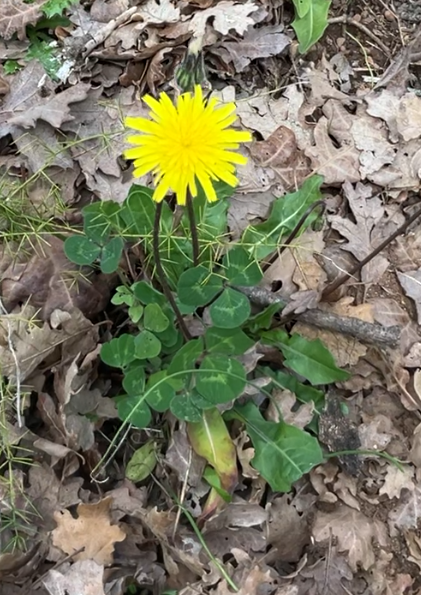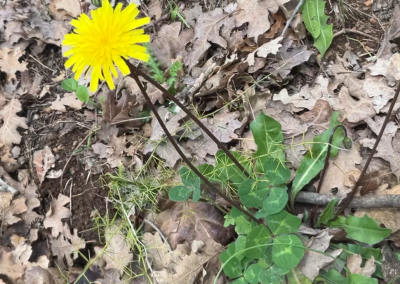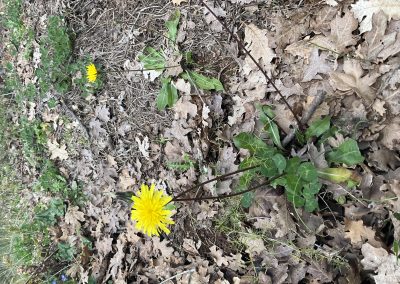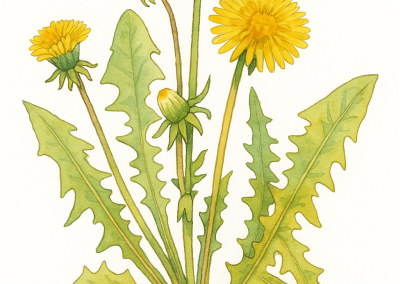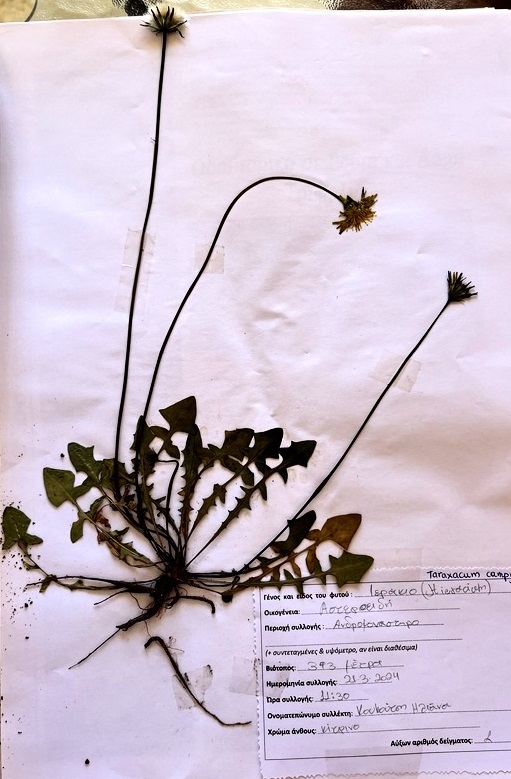Taraxacum officinale
Scientific description
Scientific name: Taraxacum officinale
Common names: Dandelion, Ταράξακος ο φαρμακευτικός, πικραλίδα
Kingdom: Plantae
Taxonomy: Magnoliophyta, Magnoliopsida (Dicotyledons), Asteridae, Asterales
Family: Asteraceae, Subfamily: Cichorioideae, Tribe: Cichorieae
Genus: Taraxacum
Species: Taraxacum officinale
Origin:
Native to Europe and Asia; introduced to the Americas as cultivated food. Naturalized across North America, South Africa, South America, New Zealand, Australia, and India.
Description:
Perennial herb. Basal leaves forming a rosette, deeply toothed or lobed ("lion's tooth"). Hollow leafless stems with milky latex. Bright yellow composite flowers, 2–5 cm diameter, bloom early spring to late autumn. Long thick taproot up to 30 cm. Seed heads ("dandelion clocks") dispersed by wind.
Propagation:
Mainly by seeds; can regenerate from root fragments.
Ecology:
Thrives in lawns, gardens, roadsides, pastures, disturbed areas. Prefers well-drained soil, full sun to partial shade. Highly adaptable, pioneer species in ecological succession.
Uses:
Culinary: flowers for wine, leaves in salads or cooked, roots roasted as coffee substitute. Medicinal: treat infections, stimulate bile, liver support, diuretic, tonic, detoxifier.
Taraxacum officinale (Ταράξακος ο φαρμακευτικός), πικραλίδα
Βασίλειο: Φυτά (Plantae)
Συνομοταξία: Αγγειόσπερμα (Magnoliophyta)
Ομοταξία: Δικοτυλήδονα (Magnoliopsida)
Υφομοταξία: Αστερίδες (Asteridae)
Τάξη: Αστερώδη (Asterales)
Οικογένεια: Αστεροειδή (Asteraceae), Υποοικογένεια: Κιχωριοειδή, Ομοιογένεια: Κιχωριέαι
Γένος: Ταράξακον (Taraxacum)
Είδος: Taraxacum officinale
Καταγωγή:
Ιθαγενές Ευρώπης και Ασίας, αρχικά εισαγόμενο στην Αμερική ως καλλιεργούμενη τροφή. Εγκλιματισμένο σε Βόρεια Αμερική, Νότια Αφρική, Νότια Αμερική, Νέα Ζηλανδία, Αυστραλία, Ινδία.
Περιγραφή:
Πολυετές ποώδες φυτό, ροζέτα φύλλων, βαθιά οδοντωτά/λοβωτά. Κοίλοι άφυλλοι μίσχοι με γαλακτώδες λατέξ. Κίτρινα σύνθετα άνθη 2–5 cm, ανθοφορία άνοιξη–φθινόπωρο. Παχιά ρίζα μέχρι 30 cm. Σφαιρικές κεφαλές σπόρων ("ρολόγια πικραλίδας").
Πολλαπλασιασμός:
Κυρίως μέσω σπόρων, μπορεί να αναγεννηθεί από τμήματα ριζών.
Οικολογία:
Ευδοκιμεί σε χλοοτάπητες, κήπους, άκρες δρόμων, βοσκότοπους και διαταραγμένες περιοχές. Κατάλληλο για καλά στραγγιζόμενα εδάφη, πλήρης ή μερική σκιά. Πρωτοπόρο είδος σε οικολογική διαδοχή.
Χρήση:
Μαγειρική: άνθη για κρασί, φύλλα σε σαλάτες ή μαγειρεμένα, ρίζες ως υποκατάστατο καφέ. Ιατρική: θεραπεία λοιμώξεων, διεγείρει χολή, υποστηρίζει ήπαρ, διουρητικό, τονωτικό, αποτοξινωτικό.
Taraxacum officinale
Règne: Plantae
Taxonomie: Magnoliophyta, Dicotylédones (Magnoliopsida), Asteridae, Asterales
Famille: Asteraceae, Sous-famille: Cichorioideae, Tribu: Cichorieae
Genre: Taraxacum
Espèce: Taraxacum officinale
Origine:
Originaire d’Europe et d’Asie, introduit en Amérique comme aliment cultivé. Naturalisation en Amérique du Nord, Afrique du Sud, Amérique du Sud, Nouvelle-Zélande, Australie et Inde.
Description:
Plante herbacée vivace. Feuilles en rosette, profondément dentées/lobées ("dent de lion"). Tiges creuses sans feuilles, latex laiteux. Fleurs jaunes composées 2–5 cm, floraison printemps à fin automne. Racine pivotante 30 cm. Capitules sphériques pour dispersion par le vent.
Propagation:
Principalement par graines; peut régénérer à partir de fragments de racine.
Écologie:
Présente dans pelouses, jardins, bords de routes, pâturages, zones perturbées. Préfère sol bien drainé, soleil ou mi-ombre. Espèce pionnière.
Utilisations:
Cuisine: fleurs pour vin, feuilles crues ou cuites, racines torréfiées comme substitut de café. Médecine: infections, stimulation biliaire, soutien hépatique, diurétique, tonique, détoxifiant.
Taraxacum officinale (Țarașac, Păpădie)
Regn: Plantae
Diviziune: Magnoliophyta
Clasă: Magnoliopsida (Dicotiledonate)
Subclasă: Asteridae
Ordin: Asterales
Familie: Asteraceae, Subfamilie: Cichorioideae, Trib: Cichorieae
Gen: Taraxacum
Specie: Taraxacum officinale
Origine:
Originar din Europa și Asia, introdus în America ca plantă alimentară. Naturalizat în America de Nord, Africa de Sud, America de Sud, Noua Zeelandă, Australia și India.
Descriere:
Plantă perenă, frunze în rozetă la sol, profund dințate/lobate ("dintele de leu"). Tulpini goale fără frunze, latex alb. Flori galbene compuse 2–5 cm, florile primăvară–toamnă. Rădăcină pivotantă 30 cm. Capetele de semințe ("ceasuri de păpădie").
Propagare:
Principal prin semințe; se poate regenera din fragmente de rădăcină.
Ecologie:
Crește în peluze, grădini, margini de drum, pășuni, zone perturbate. Sol bine drenat, soare sau umbră parțială. Specie pionieră.
Utilizări:
Culinar: flori pentru vin, frunze crude sau gătite, rădăcini prăjite ca substitut de cafea. Medicinal: infecții, stimulare bilă, suport hepatic, diuretic, tonic, detoxifiant.
Creative writing inspired by Taraxacum officinale
Taraxacum officinale — Taraxa
In the days of old, there lived a young healer named Taraxa, known for her profound knowledge of herbs and remedies. Taraxa had a gift: she could listen to the whispers of the wind, which would carry secrets of nature to her ears. She wandered the meadows and forests, gathering plants that could cure illnesses and soothe the suffering. Among the many plants she collected, one stood out—a humble yellow flower with delicate seeds that floated on the breeze. This was the dandelion.
One year, a great sickness spread across the land, and no herb seemed to bring relief. Desperate to find a cure, Taraxa listened more closely to the wind, and it guided her to the dandelion. The plant, though often ignored and called a weed by many, had incredible powers of healing. Taraxa made a tea from its roots and leaves, and the people who drank it were miraculously healed.
The gods, impressed by Taraxa’s wisdom and her ability to see the true value of even the most overlooked plants, blessed her with long life and the eternal ability to heal others. From that moment, the dandelion became known as a powerful medicinal plant, and people began to call it Taraxacum officinale in honor of the healer.
The villagers named the plant πικραλίδα (from "πικρός" meaning "bitter" and "λίδα" meaning "flower"), as its bitter taste concealed its incredible healing properties. It became a symbol of hidden strength and the power of nature’s simplest gifts. Even today, the sight of dandelions floating on the wind is said to carry the spirit of Taraxa, spreading healing wherever they land.


